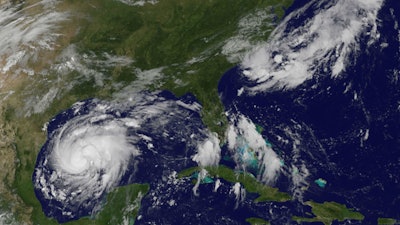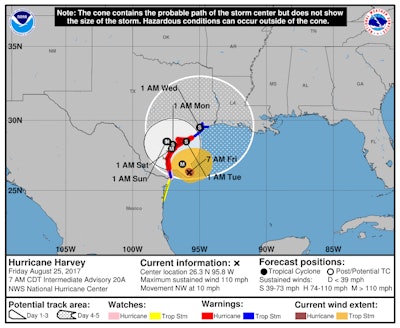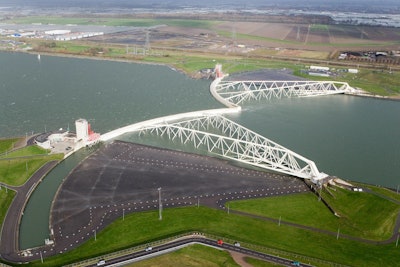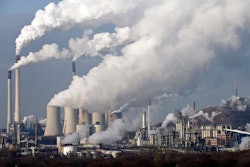
Forecasters now predict Harvey will be the strongest storm to hit the U.S. in 12 years.
This morning, the National Weather Service said that Texans along the coast only have a few hours left to evacuate. Overnight, Tropical Storm Harvey intensified into a Category 3 hurricane. Most recently, Harvey was classified as a Category 2 hurricane with maximum wind speeds near 105 mph, but Harvey is expected to intensify as it makes landfall later today, with winds as high as 110 mph. Texas will likely be pummeled by rain and high winds for several days.
Yesterday, CNBC reported that many in the energy industry are watching nervously and preparing for the possibility of extreme winds and a storm surge.
Several companies in the region, including Anadarko Petroleum Corp. and ExxonMobil, have already begun evacuating workers from offshore platforms and cutting production.
One of the other concerns is the impact of flooding on refining facilities.
 Source: National Weather Service
Source: National Weather ServiceThe Gulf Coast in Texas is home to about half of the country’s refining capacity. One analyst says that the rule of thumb is that if the storm is a Category 1, it will take about a week to restore refining operations. A Category 2 hurricane could knock out the facilities for up to two weeks.
This situation could also be dangerous for chemical facilities in the area.
Building a barrier to protect the region’s network of chemical plants has been a hot-button issue for years.
In 2016, a committee was formed to come up with a solution to protect the Houston Ship Channel’s chemical plants and oil refineries, but progress was stymied by competing views about what kind of barrier would work best.
Earlier this year, ramped up efforts to get something done by asking President Trump for $15 billion in federal funds to build a barrier to protect Houston from a storm surge.
The Texas General Land Office Commissioner called the region "crucial to national security" because it houses over half of the country’s jet fuel and is the No. 1 energy supplier for the U.S. military.
A coastal barrier system would also protect the 6 million people who live and work in the region.
Worries about the next “big one” have increased since Hurricane Ike in 2008, which hammered the Texan coast, killed 74 people and caused $29.5 billion in damages.
Now, the series of seawalls and floodgates Texan lawmakers hope to build is commonly referred to as an “Ike Dike” and would be similar to the Dutch Delta Works — often considered one of the “seven wonders of the modern world.” The floodgates many engineers envision for Houston would be 800 feet wide, compared to the 1,183 feet-wide-gates that protect the Netherlands.
For now, though, the people and facilities along the coast are still vulnerable to whatever conditions Harvey brings.
 Dutch Delta Works. Image: Lauwersmeer.org
Dutch Delta Works. Image: Lauwersmeer.org





















